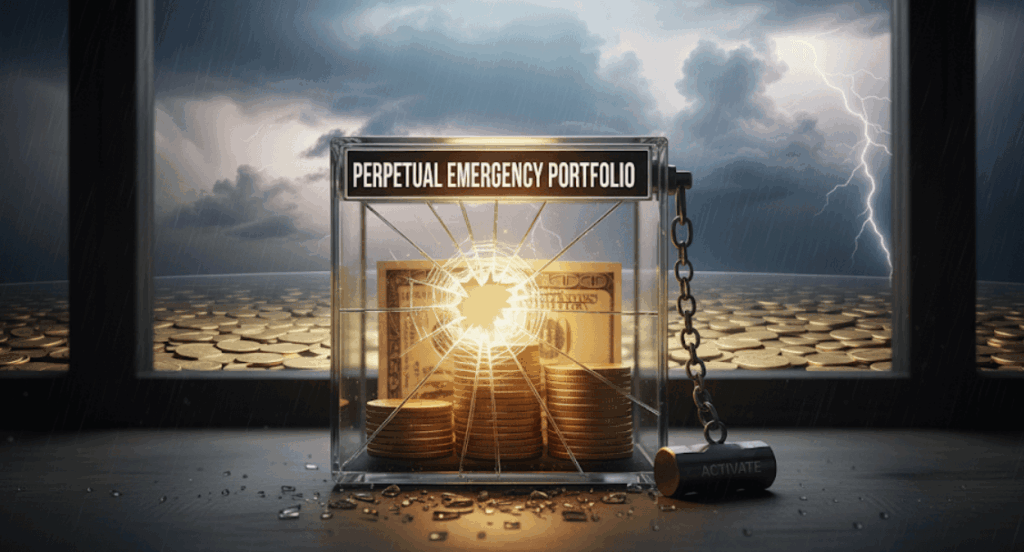
You’ve hit your FIRE number. Congratulations. Your portfolio now covers your budgeted living expenses, theoretically, forever.
So, why listen to the standard advice about keeping 3-6 months of expenses in cash? That advice is designed to buffer against job loss, but you’ve already retired. The traditional emergency fund model seems obsolete.
However, while you may not fear a layoff, you still have to contend with reality. Your water heater doesn’t care about your 4% Safe Withdrawal Rate.
In FIRE, the real risk isn’t income interruption; it’s the unexpected $10,000 expense during a market downturn. This forces you to sell more shares than planned, potentially crippling your portfolio’s long-term viability (Sequence of Return Risk).
We need a different approach. We need a Perpetual Emergency Portfolio (PEP).
The Concept: A Self-Sustaining Insurance Policy
The PEP is a dedicated investment account designed to cash-flow emergencies using the same 4% rule we use for retirement. It’s a volatility buffer, entirely separate from the portfolio you use for living expenses.
The goal is to determine the average annual cost of unexpected, non-budgeted expenses and then build a portfolio large enough to cover that cost indefinitely.
Step 1: The Annual Cost of Chaos (The Actuarial Approach)
To determine the size of the PEP, we can’t just guess. We need to analyze what emergencies actually cost and, crucially, how often they occur.
If we just added up the cost of every possible disaster, the total would be paralyzing. But your HVAC won’t fail every year. We must calculate the annualized cost of each emergency. We do this by multiplying the cost of the event by the probability of it happening in any given year.
(Note: Frequencies are highly personal, but these assumptions provide a generalized model.)
| Emergency | Cost | Annual Frequency | Annual Cost |
| Medical | $5,000 | 15% (Every ~7 yrs) | $750 |
| Dental | $1,500 | 30% (Every ~3 yrs) | $450 |
| Pet Care | $2,000 | 25% (Every 4 yrs) | $500 |
| Minor Home Repairs | $2,500 | 50% (Every 2 yrs) | $1,250 |
| Major Home Repair | $10,000 | 7% (Every ~15 yrs) | $700 |
| Car Repairs | $2,500 | 35% (Every ~3 yrs) | $875 |
| Family Support | $2,000 | 25% (Every 4 yrs) | $500 |
| Essential Travel | $1,500 | 15% (Every ~7 yrs) | $225 |
| Legal Fees | $2,000 | 10% (Every 10 yrs) | $200 |
| Cell Phone | $800 | 33% (Every 3 yrs) | $264 |
| Laptop | $1,200 | 20% (Every 5 yrs) | $240 |
| Appliance | $2,000 | 20% (Every 5 yrs) | $400 |
| ANNUAL COST | $6,354 |
On average, based on this model, you can expect $6,354 in unexpected expenses per year. Some years it will be zero; the year the roof leaks and the car breaks, it might be $12,000.
Step 2: Calculate Your “Emergency FIRE Number”
Now we apply the magic of the 4% Safe Withdrawal Rate. If we want this portfolio to cover $6,354 per year indefinitely:
$6,354 / 0.04 (or $6,354 * 25) = $158,850
The target size for the Perpetual Emergency Portfolio is $158,850.
This fund is designed to completely insulate your main FIRE portfolio. When fully funded, it should generate enough returns over time to handle the average year’s disasters without selling the principal.
Step 3: The Investment Strategy—Why Cash is Not King Here
A traditional emergency fund is kept in cash. For a Perpetual Emergency Portfolio, this is inefficient. We are relying on the average annual cost, and we want the principal to grow to keep pace with the inflating costs of repairs and medical care.
It must be invested.
I have specifically chosen the Acorns investment platform for my PEP. While I use different brokerages for my core portfolio, Acorns offers unique features perfect for this specific job:
1. Psychological Separation
It is vital that this fund is separate from both my checking account and my main investments. This “out of sight, out of mind” approach prevents raiding the fund for non-emergencies and provides a clear distinction between “life money” and “emergency money.”
2. Automated, Frictionless Growth
The best defense is one you don’t have to manage actively. Acorns utilizes:
- Round-Ups: Spare change from everyday purchases is automatically invested into the PEP.
- Recurring Transfers: Small, consistent transfers ensure the portfolio is constantly being fed.
This ensures the PEP is always growing and automatically “refills” itself after withdrawals, taking advantage of dollar-cost averaging without manual effort.
3. Simplified Allocation
We don’t need complex strategies. Acorns provides prebuilt, diversified portfolios (including equities, bonds, and even a Bitcoin ETF). Because this fund still needs stability for withdrawals, a “Moderate” allocation might be ideal—providing growth while reducing short-term volatility. (We’ll dive deeper into the specific allocation strategy in the next post).
The End Goal: True Financial Resilience
By shifting from a finite cash reserve to a Perpetual Emergency Portfolio, you create a self-sustaining insurance policy. It fundamentally reduces the risk of ever running out of money, allowing you to maintain your early retirement lifestyle through whatever life throws at you.
